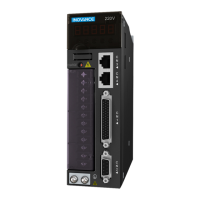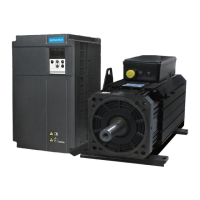IS620P User Manual Chapter 6 Troubleshooting
- 153 -
Cause Conrming Method Corrective Action
3. The acceleration/
deceleration is too
frequent or the load
inertia is too large.
•
Calculate the load inertia ratio
or perform the load inertia ratio
auto-tuning. Then view H08-15
(load inertia ratio).
•
Conrm the single running cycle
when the servo motor runs in
circular
Increase acceleration/deceleration
time during single running.
4. The gain is improper,
causing too high rigidity.
•
Observe whether the motor
vibrates and generates noise
during running.
Adjust the gain by referring to
chapter 4.
5. The servo drive or
motor model is set
incorrectly.
•
For IS620P series products,
view the bus motor model in
H00-05 and the servo drive
model in H01-02.
•
For the IS600P series product,
view the servo motor model
in H00-00 and the servo drive
model in H01-02.
View the servo drive nameplate and
set the servo drive model (H01-02)
correctly and replace with matching
servo motor section 1.2 Servo
System Conguration.
6. Locked-rotor occurs
due to mechanical
factors, resulting in
very heavy load during
running.
•
Check the running reference
and the actual motor speed
(H0B-00) by using the drive
debugging platform of Inovance
or the operation panel.
Running reference in the
position control mode: H0B-13
(input reference pulse counter)
Running reference in the speed
control mode: H0B-01 (speed
reference)
Running reference in the torque
control mode: H0B-02 (internal
torque reference)
Check the running reference in
corresponding mode is not 0
but the motor speed is 0.
Solve mechanical problems.
7. The servo drive is
faulty.
•
Power on the servo drive and
then re-power on it.
If the fault remains after re-power-
on, replace the servo drive.

